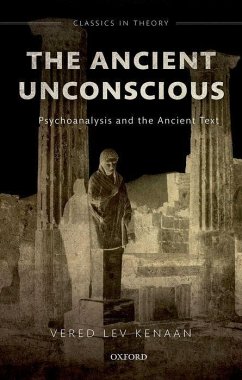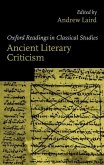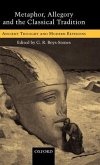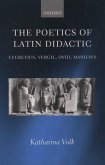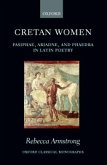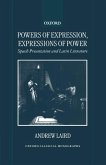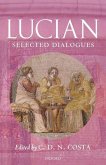- Gebundenes Buch
- Merkliste
- Auf die Merkliste
- Bewerten Bewerten
- Teilen
- Produkt teilen
- Produkterinnerung
- Produkterinnerung
Although cognitive psychology and neuroscience have usurped the influential position once held by psychoanalysis, this volume seeks to reclaim the value of the unconscious as a methodological tool for the study of ancient texts by transforming our understanding of what it means, how it operates, and how it relates to textual hermeneutics.
Andere Kunden interessierten sich auch für
![Ancient Literary Criticism Ancient Literary Criticism]() Andrew Laird (ed.)Ancient Literary Criticism317,99 €
Andrew Laird (ed.)Ancient Literary Criticism317,99 €![Metaphor, Allegory, and the Classical Tradition Metaphor, Allegory, and the Classical Tradition]() G.R. Boys-Stones (ed.)Metaphor, Allegory, and the Classical Tradition214,99 €
G.R. Boys-Stones (ed.)Metaphor, Allegory, and the Classical Tradition214,99 €![The Poetics of Latin Didactic The Poetics of Latin Didactic]() Katharina VolkThe Poetics of Latin Didactic261,99 €
Katharina VolkThe Poetics of Latin Didactic261,99 €![Cretan Women Cretan Women]() Rebecca ArmstrongCretan Women239,99 €
Rebecca ArmstrongCretan Women239,99 €![The Function of Humour in Roman Verse Satire The Function of Humour in Roman Verse Satire]() Maria PlazaThe Function of Humour in Roman Verse Satire98,99 €
Maria PlazaThe Function of Humour in Roman Verse Satire98,99 €![Powers of Expression, Expressions of Power Powers of Expression, Expressions of Power]() Andrew LairdPowers of Expression, Expressions of Power95,99 €
Andrew LairdPowers of Expression, Expressions of Power95,99 €![Lucian Lucian]() C. D. N. Costa (ed.)Lucian110,99 €
C. D. N. Costa (ed.)Lucian110,99 €-
-
-
Although cognitive psychology and neuroscience have usurped the influential position once held by psychoanalysis, this volume seeks to reclaim the value of the unconscious as a methodological tool for the study of ancient texts by transforming our understanding of what it means, how it operates, and how it relates to textual hermeneutics.
Hinweis: Dieser Artikel kann nur an eine deutsche Lieferadresse ausgeliefert werden.
Hinweis: Dieser Artikel kann nur an eine deutsche Lieferadresse ausgeliefert werden.
Produktdetails
- Produktdetails
- Verlag: Oxford University Press (UK)
- Seitenzahl: 240
- Erscheinungstermin: 8. Juli 2019
- Englisch
- Abmessung: 218mm x 145mm x 23mm
- Gewicht: 431g
- ISBN-13: 9780198827795
- ISBN-10: 0198827792
- Artikelnr.: 56397694
- Herstellerkennzeichnung
- Libri GmbH
- Europaallee 1
- 36244 Bad Hersfeld
- gpsr@libri.de
- Verlag: Oxford University Press (UK)
- Seitenzahl: 240
- Erscheinungstermin: 8. Juli 2019
- Englisch
- Abmessung: 218mm x 145mm x 23mm
- Gewicht: 431g
- ISBN-13: 9780198827795
- ISBN-10: 0198827792
- Artikelnr.: 56397694
- Herstellerkennzeichnung
- Libri GmbH
- Europaallee 1
- 36244 Bad Hersfeld
- gpsr@libri.de
Vered Lev Kenaan is Professor of Classics and Comparative Literature at the University of Haifa. As an interpreter of culture and myths, her writing centres on the relationships between psychoanalysis and literature, intertextuality and the interpretation of dreams, textuality and gender: her book, Pandora's Senses: The Feminine Character of the Ancient Text (Wisconsin, 2008) interprets the myth of the first woman and shows how femininity is embedded in canonical texts reflecting male hegemony. Her investigations of Greek and Roman mythology led to the creation of a series of public lectures at the University of Haifa dedicated to the contribution of myth to the humanities, the arts, and the social sciences. She is the chief editor of a book series 'Myth in the Humanities' published by Haifa University Press and Pardes Publishing House, and is also editor of the journal Dappim: Research in Literature.
Frontmatter
List of Illustrations
0: Introduction
1: The Ancient Unconscious? Towards a Methodology
1.1: Philology's Complexes
1.2: Facing Ancient Experience
1.3: Psychologizing the Ancients: The Case of E. R. Dodds
1.4: The Unconscious and Gadamer's Fusion of Times
1.5: Anachronism as a New Philological Project
1.6: Antiquity and Modernity: The Familiar Strangers
2: Hegel's Antiquity: Far Away, So Close
2.1: The Past: Buried and Unburied
2.2: Antiquity: A Fountainhead of Ambiguities
2.3: Self-Estrangement
2.4: Golden Apples in Silver Bowls
2.5: Antiquity as Mother-Earth
2.6: The Antaeus Complex
2.7: Veiled Antiquity
3: Freud on the Acropolis
3.1: From Hegel's Antaeus to Freud's Oedipus
3.2: The Death of the Father and the Reawakened Past
3.3: A View from the Acropolis
3.4: parvis componere magna
3.5: The Future Unveiling of Tityrus' Unconscious
3.6: Virgil's Unveiling of Freud's Unconscious
4: Childhood Memories: Homeric Digression and Freudian Regression
4.1: Freud's alte Zeiten
4.2: From Mythic to Psychological Memory
4.3: Memory as a Digression
4.4: Remembering and Forgetting
4.5: (Where on earth are they?)
4.6: The Return of the Primordial Washing Scene
4.7: The Scar and the Dream Navel
5: The Unconscious as a Figura Futurorum
5.1: From Universalism to a Theory of Analogies
5.2: Linkings
5.3: Temporalities
6: Oedipal Dreams: The Ancient and Modern Unconscious
6.1: Dreaming about Oedipus
6.2: The Unconscious at the Crossroads
6.3: The Oedipal Dream: Backwards and Forwards
6.4: The Future of Dreams
6.5: Past Translated into Future
6.6: Disguised and Undisguised Oedipal Dreams
6.7: Asexual Oedipal Dreams: An Ancient Case of Repression?
6.8: Artemidorus' Unconscious
6.9: The Sexual Mother
6.10: Aeneas' Oedipal Dream
Endmatter
Bibliography
Index
List of Illustrations
0: Introduction
1: The Ancient Unconscious? Towards a Methodology
1.1: Philology's Complexes
1.2: Facing Ancient Experience
1.3: Psychologizing the Ancients: The Case of E. R. Dodds
1.4: The Unconscious and Gadamer's Fusion of Times
1.5: Anachronism as a New Philological Project
1.6: Antiquity and Modernity: The Familiar Strangers
2: Hegel's Antiquity: Far Away, So Close
2.1: The Past: Buried and Unburied
2.2: Antiquity: A Fountainhead of Ambiguities
2.3: Self-Estrangement
2.4: Golden Apples in Silver Bowls
2.5: Antiquity as Mother-Earth
2.6: The Antaeus Complex
2.7: Veiled Antiquity
3: Freud on the Acropolis
3.1: From Hegel's Antaeus to Freud's Oedipus
3.2: The Death of the Father and the Reawakened Past
3.3: A View from the Acropolis
3.4: parvis componere magna
3.5: The Future Unveiling of Tityrus' Unconscious
3.6: Virgil's Unveiling of Freud's Unconscious
4: Childhood Memories: Homeric Digression and Freudian Regression
4.1: Freud's alte Zeiten
4.2: From Mythic to Psychological Memory
4.3: Memory as a Digression
4.4: Remembering and Forgetting
4.5: (Where on earth are they?)
4.6: The Return of the Primordial Washing Scene
4.7: The Scar and the Dream Navel
5: The Unconscious as a Figura Futurorum
5.1: From Universalism to a Theory of Analogies
5.2: Linkings
5.3: Temporalities
6: Oedipal Dreams: The Ancient and Modern Unconscious
6.1: Dreaming about Oedipus
6.2: The Unconscious at the Crossroads
6.3: The Oedipal Dream: Backwards and Forwards
6.4: The Future of Dreams
6.5: Past Translated into Future
6.6: Disguised and Undisguised Oedipal Dreams
6.7: Asexual Oedipal Dreams: An Ancient Case of Repression?
6.8: Artemidorus' Unconscious
6.9: The Sexual Mother
6.10: Aeneas' Oedipal Dream
Endmatter
Bibliography
Index
Frontmatter
List of Illustrations
0: Introduction
1: The Ancient Unconscious? Towards a Methodology
1.1: Philology's Complexes
1.2: Facing Ancient Experience
1.3: Psychologizing the Ancients: The Case of E. R. Dodds
1.4: The Unconscious and Gadamer's Fusion of Times
1.5: Anachronism as a New Philological Project
1.6: Antiquity and Modernity: The Familiar Strangers
2: Hegel's Antiquity: Far Away, So Close
2.1: The Past: Buried and Unburied
2.2: Antiquity: A Fountainhead of Ambiguities
2.3: Self-Estrangement
2.4: Golden Apples in Silver Bowls
2.5: Antiquity as Mother-Earth
2.6: The Antaeus Complex
2.7: Veiled Antiquity
3: Freud on the Acropolis
3.1: From Hegel's Antaeus to Freud's Oedipus
3.2: The Death of the Father and the Reawakened Past
3.3: A View from the Acropolis
3.4: parvis componere magna
3.5: The Future Unveiling of Tityrus' Unconscious
3.6: Virgil's Unveiling of Freud's Unconscious
4: Childhood Memories: Homeric Digression and Freudian Regression
4.1: Freud's alte Zeiten
4.2: From Mythic to Psychological Memory
4.3: Memory as a Digression
4.4: Remembering and Forgetting
4.5: (Where on earth are they?)
4.6: The Return of the Primordial Washing Scene
4.7: The Scar and the Dream Navel
5: The Unconscious as a Figura Futurorum
5.1: From Universalism to a Theory of Analogies
5.2: Linkings
5.3: Temporalities
6: Oedipal Dreams: The Ancient and Modern Unconscious
6.1: Dreaming about Oedipus
6.2: The Unconscious at the Crossroads
6.3: The Oedipal Dream: Backwards and Forwards
6.4: The Future of Dreams
6.5: Past Translated into Future
6.6: Disguised and Undisguised Oedipal Dreams
6.7: Asexual Oedipal Dreams: An Ancient Case of Repression?
6.8: Artemidorus' Unconscious
6.9: The Sexual Mother
6.10: Aeneas' Oedipal Dream
Endmatter
Bibliography
Index
List of Illustrations
0: Introduction
1: The Ancient Unconscious? Towards a Methodology
1.1: Philology's Complexes
1.2: Facing Ancient Experience
1.3: Psychologizing the Ancients: The Case of E. R. Dodds
1.4: The Unconscious and Gadamer's Fusion of Times
1.5: Anachronism as a New Philological Project
1.6: Antiquity and Modernity: The Familiar Strangers
2: Hegel's Antiquity: Far Away, So Close
2.1: The Past: Buried and Unburied
2.2: Antiquity: A Fountainhead of Ambiguities
2.3: Self-Estrangement
2.4: Golden Apples in Silver Bowls
2.5: Antiquity as Mother-Earth
2.6: The Antaeus Complex
2.7: Veiled Antiquity
3: Freud on the Acropolis
3.1: From Hegel's Antaeus to Freud's Oedipus
3.2: The Death of the Father and the Reawakened Past
3.3: A View from the Acropolis
3.4: parvis componere magna
3.5: The Future Unveiling of Tityrus' Unconscious
3.6: Virgil's Unveiling of Freud's Unconscious
4: Childhood Memories: Homeric Digression and Freudian Regression
4.1: Freud's alte Zeiten
4.2: From Mythic to Psychological Memory
4.3: Memory as a Digression
4.4: Remembering and Forgetting
4.5: (Where on earth are they?)
4.6: The Return of the Primordial Washing Scene
4.7: The Scar and the Dream Navel
5: The Unconscious as a Figura Futurorum
5.1: From Universalism to a Theory of Analogies
5.2: Linkings
5.3: Temporalities
6: Oedipal Dreams: The Ancient and Modern Unconscious
6.1: Dreaming about Oedipus
6.2: The Unconscious at the Crossroads
6.3: The Oedipal Dream: Backwards and Forwards
6.4: The Future of Dreams
6.5: Past Translated into Future
6.6: Disguised and Undisguised Oedipal Dreams
6.7: Asexual Oedipal Dreams: An Ancient Case of Repression?
6.8: Artemidorus' Unconscious
6.9: The Sexual Mother
6.10: Aeneas' Oedipal Dream
Endmatter
Bibliography
Index

